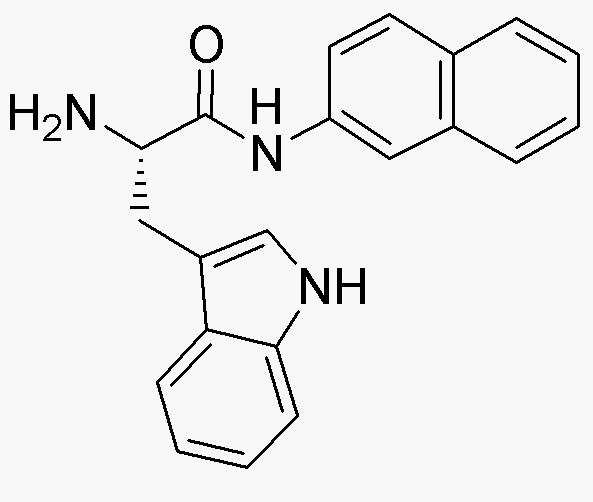L-Tryptophan b-naphthylamide is widely utilized in research focused on:
- Pharmaceutical Development: This compound serves as a valuable intermediate in the synthesis of various pharmaceuticals, particularly those targeting neurological disorders, due to its role in serotonin production.
- Biochemical Research: It is often used in studies investigating protein interactions and enzyme activities, helping researchers understand complex biological processes.
- Food Industry: As a dietary supplement, it is incorporated into formulations aimed at improving mood and sleep quality, appealing to consumers seeking natural health solutions.
- Cosmetic Applications: The compound is explored for its potential benefits in skin care products, particularly for its antioxidant properties, which can help protect skin from damage.
- Animal Nutrition: It is included in animal feed to enhance growth and improve overall health, demonstrating its versatility across different sectors.
General Information
Properties
Safety and Regulations
Applications
L-Tryptophan b-naphthylamide is widely utilized in research focused on:
- Pharmaceutical Development: This compound serves as a valuable intermediate in the synthesis of various pharmaceuticals, particularly those targeting neurological disorders, due to its role in serotonin production.
- Biochemical Research: It is often used in studies investigating protein interactions and enzyme activities, helping researchers understand complex biological processes.
- Food Industry: As a dietary supplement, it is incorporated into formulations aimed at improving mood and sleep quality, appealing to consumers seeking natural health solutions.
- Cosmetic Applications: The compound is explored for its potential benefits in skin care products, particularly for its antioxidant properties, which can help protect skin from damage.
- Animal Nutrition: It is included in animal feed to enhance growth and improve overall health, demonstrating its versatility across different sectors.
Documents
Safety Data Sheets (SDS)
The SDS provides comprehensive safety information on handling, storage, and disposal of the product.
Product Specification (PS)
The PS provides a comprehensive breakdown of the product’s properties, including chemical composition, physical state, purity, and storage requirements. It also details acceptable quality ranges and the product's intended applications.
Certificates of Analysis (COA)
Search for Certificates of Analysis (COA) by entering the products Lot Number. Lot and Batch Numbers can be found on a product’s label following the words ‘Lot’ or ‘Batch’.
*Catalog Number
*Lot Number
Certificates Of Origin (COO)
This COO confirms the country where the product was manufactured, and also details the materials and components used in it and whether it is derived from natural, synthetic, or other specific sources. This certificate may be required for customs, trade, and regulatory compliance.
*Catalog Number
*Lot Number
Safety Data Sheets (SDS)
The SDS provides comprehensive safety information on handling, storage, and disposal of the product.
DownloadProduct Specification (PS)
The PS provides a comprehensive breakdown of the product’s properties, including chemical composition, physical state, purity, and storage requirements. It also details acceptable quality ranges and the product's intended applications.
DownloadCertificates of Analysis (COA)
Search for Certificates of Analysis (COA) by entering the products Lot Number. Lot and Batch Numbers can be found on a product’s label following the words ‘Lot’ or ‘Batch’.
*Catalog Number
*Lot Number
Certificates Of Origin (COO)
This COO confirms the country where the product was manufactured, and also details the materials and components used in it and whether it is derived from natural, synthetic, or other specific sources. This certificate may be required for customs, trade, and regulatory compliance.


